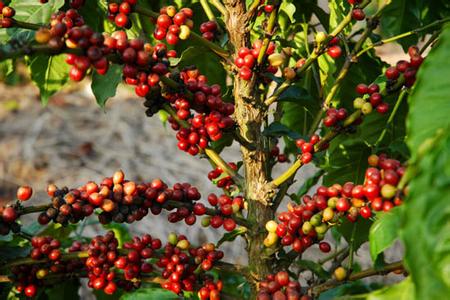Important conditions of Coffee cultivation
The annual average temperature of the coffee belt is above 20 ℃, because the coffee tree is a tropical plant and cannot grow normally if the temperature is below 20 ℃.

1. Climatic conditions
Atobika coffee is not resistant to high temperature and humid climate, nor can it stay at a low temperature below 5 ℃ for a long time, so it is planted on steep slopes at an altitude of 1000-2000 meters. On the other hand, Robusta coffee is cultivated in lowlands below 1000 meters above sea level because of its strong adaptability (Robusta's original meaning is "tenacious and strong").
Annual average rainfall, rainfall of 1000-2000 mm, coupled with appropriate sunshine, is the most suitable environment for coffee growth. But Arabica coffee is not resistant to strong sunlight and extreme heat, so it is suitable for growing in terrain prone to morning fog, especially where there is a large temperature difference between day and night. In addition, in order to avoid direct sunlight, shelter trees, such as bananas, maize and mango trees, will be planted in working places.
2. Soil quality
To put it simply, the soil suitable for growing coffee is fertile volcanic soil with enough moisture and moisture and rich in organic matter. The Ethiopian plateau is covered with this kind of volcanic rock weathered soil, so. Soil rich in humus has naturally become one of the basic conditions suitable for growing coffee.
In fact, coffee production areas such as the Brazilian highlands (known as "Terra rossa", meaning fertile red soil weathered by basalt), the highlands of Central America, the surrounding Andes of South America, the African highlands, the West Indies, Java (some of the soils are also volcanic rocks, or a mixture of volcanic ash and humus), have rich and rich soils with plenty of water, just like the Ethiopian highlands.
Soil has a subtle effect on the taste of coffee. For example, coffee grown on slightly acidic soil will also have a strong sour taste; for example, the soil around Rio de Janeiro has an iodine flavor, and when picking coffee beans, the fruit will be shaken to the ground by shaking trees, and the coffee will also be contaminated with that unique flavor.
3. Topography and height
It is generally believed that the coffee produced in the highlands is of better quality. Coffee-producing countries in Central America will use "elevation" as the grading standard because of the mountains that cross the middle of the continent. For example, SHB in Guatemala (abbreviated from the prefix Strictly Hard Bean), the highest of the seven grades is called SHB, indicating that its producing area is about 1370 meters above sea level.
Although the coffee farm is located on steep slopes and is not convenient for transportation, transportation, cultivation and management, this terrain has low temperatures and is prone to morning fog, which can ease the strong sunshine peculiar to the tropics and allow time for the coffee fruit to fully mature.
However, premium coffee such as "Blue Mountain" and "Hawaiian Kona" on the island of Jamaica are not harvested in the highlands. Because as long as there is the right temperature, rainfall and soil, there will be morning fog and a large temperature difference between day and night, mountain high-quality coffee can be planted. It can be seen that even if "high real estate equals high quality", it does not mean that "low real estate equals low quality". Elevation can only be regarded as one of the reference criteria for judging the grade of coffee. Although elevation is important, the topography and climatic conditions of the producing area are more important.
European countries, the main consumer of coffee, gave high praise to highland coffee such as Kenya and Colombia a long time ago. Quantitative coffee beans can extract more coffee liquid (that is, higher concentration), which is one of the reasons why Highland Coffee is well received.
In addition, as mentioned earlier, Robusta coffee, which is native to the Congo, is grown in the lowlands below 1000 meters above sea level. Unlike Arabica, it grows fast and is resistant to diseases and insect pests, and can be grown in non-fertile soil. Therefore, the taste and aroma are far inferior to Arabica coffee. I don't totally disapprove of Robusta growing coffee, but in principle I don't use Robusta to grow coffee. The reason is actually very simple, but I want to drink higher quality coffee, but also want everyone to enjoy better quality coffee.
Important Notice :
前街咖啡 FrontStreet Coffee has moved to new addredd:
FrontStreet Coffee Address: 315,Donghua East Road,GuangZhou
Tel:020 38364473
- Prev

The mysterious veil of coffee
The world's first coffee tree was discovered by shepherds in Ethiopia.
- Next

Coffee drinking etiquette that needs to be paid attention to
When it comes to coffee drinking etiquette, in fact, there are many people do not know, including many rich bosses, wives who still look very ladylike, and some very fashionable beauties, handsome guys and so on.
Related
- How did the Salvadoran coffee industry develop in Central America?
- What exactly does the golden cup extraction of coffee mean?
- The Origin of Coffee flower
- [2023 Starbucks World Earth Day] there are more meaningful things besides free Starbucks coffee!
- What kind of coffee is there in Spain? 9 Flavors of Spanish Coffee
- Aromatic African coffee| Kenya's coffee culture and historical production area
- Liberica Coffee Bean knowledge: the characteristics of Liberian Coffee beans of the three original species of Coffee beans
- The origin and formula of Spanish latte introduces the taste characteristics of Bombon coffee in Valencia, Spain.
- How to adjust the solution of over-extracted coffee
- What is the tasting period of coffee beans? What is the period of coffee and beans? How should coffee wake up and raise beans?

